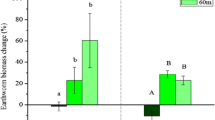Abstract
This study investigated the impact of epigeic and (epi)anecic earthworms on the distribution and availability of zinc in the soil profile. Experiments were carried out with Lumbricus rubellus and Lumbricus terrestris in perspex columns (Ø 10 cm), filled with 20 to 23 cm non-polluted soil [organic matter 2%, clay 2.9%, pH 6.4 (0.01 M CaCl2)], that was covered by a 3- to 5-cm layer of aged zinc-spiked soil (500 mg Zn/kg dry soil) and another 2 cm non-polluted soil on top. After 80 days, columns were sacrificed and sampled in a depth profile. Earthworm casts, deposited on top of the soil, were collected. Each sample was analyzed for total and 0.01 M CaCl2-exchangeable zinc concentrations. L. rubellus did not go deeper than 3 cm into the soil and therefore no effect on zinc distribution in the soil could be detected. For L. terrestris, total zinc concentrations in the non-polluted layers were slightly but significantly higher in columns with earthworms, and so were the CaCl2-exchangeable zinc concentrations in the polluted layers of these columns. Casts of L. terrestris collected from the soil surface showed higher total zinc concentrations than those from non-polluted soil. Casts were mainly placed on top of the soil. This study showed that these epigeic and (epi)anecic species have only a slight effect on zinc availability, and that deep burrowing species, like L. terrestris, are able to transport polluted soil from deeper layers to the soil surface.

Similar content being viewed by others
References
Armour-Chelu M, Andrews P (1994) Some effects of bioturbation by earthworms (Oligochaeta) on archaeological sites. J Archaeol Sci 21:433–443
Binet F, Curmi P (1992) Structural effects of Lumbricus terrestris (Oligochaeta: Lumbricidae) on the soil-organic matter system: micromorphological observations and autoradiographs. Soil Biol Biochem 12:1519–1523
Binet F, Fayolle L, Pussard M (1998) Significance of earthworms in stimulating soil microbial activity. Biol Fertil Soils 27:79–84
Cheng JM, Wong MH (2002) Effects of earthworms on Zn fractionation in soils. Biol Fertil Soils 36:72–78
Jégou D, Cluzeau D, Wolf HJ, Gandon Y, Tréhen P (1998) Assessment of the burrow system of Lumbricus terrestris, Aporrectodea giardi and Aporrectodea caliginosa using X-ray computed tomography. Biol Fertil Soils 26:116–121
Jégou D, Schrader S, Diestel H, Cluzeau D (2001) Morphological, physical and biochemical characteristics of burrow walls formed by earthworms. Appl Soil Ecol 17:165–174
Johnson DL (2002) Darwin would be proud: bioturbation, dynamic denudation, and the power of theory in science. Geoarchaeology 17:7–40
Lamandé M, Hallaire V, Curmi P, Pérès G, Cluzeau D (2003) Changes of pore morphology, infiltration and earthworm community in a loamy soil under different agricultural managements. Catena 54:637–649
Lavelle P, Spain AV (2001) Soil ecology. Kluwer, Dordrecht
Le Bayon RC, Binet F (1999) Rainfall effects on erosion of earthworm casts and phosphorus transfers by water runoff. Biol Fertil Soils 30:7–13
Le Bayon RC, Binet F (2001) Earthworm surface casts affect soil erosion by runoff water and phosphorus transfer in a temperate maize crop. Pedobiologia 45:430–442
Luepromchai E, Singer AC, Yang C-H, Crowley DE (2002) Interactions of earthworms with indigenous and bioaugmented PCB-degrading bacteria. FEMS Microbiol Ecol 41:191–197
Ma Y, Dickinson NM, Wong MH (2003) Interactions between earthworms, trees, soil nutrition and metal mobility in amended Pb/Zn mine tailings from Guangdong, China. Soil Biol Biochem 35:1369–1379
Nordström S, Rundgren S (1973) Associations of lumbricids in southern Sweden. Pedobiologia 13:301–326
Pitkanen J, Nuutinen V (1998) Earthworm contribution to infiltration and surface runoff after 15 years of different soil management. Appl Soil Ecol 9:411–415
Schrader S (1994) Influence of earthworms on the pH conditions of their environment by cutaneous mucus secretion. Zool Anz 233:211–219
Schulman OP, Tuinov AV (1999) Leaf litter fragmentation by the earthworm Lumbricus terrestris L. Pedobiologia 43:453–458
Sims RW, Gerard BM (1999) Earthworms. Notes for the identification of British species. Field Studies Council, Shrewsbury
Singer AC, Jury W, Luepromchai E, Yahng C-S, Crowley DE (2001) Contribution of earthworms to PCB bioremediation. Soil Biol Biochem 33:765–776
Smit CE, Van Beelen P, Van Gestel CAM (1997) Development of zinc bioavailability and toxicity for the springtail Folsomia candida in an experimentally contaminated field plot. Environ Pollut 98:73–80
Sokal RR, Rohlf FJ (1969) Biometry. The principles and practice of statistics in biological research. Freeman, San Francisco
Systat (1992) SYSTAT 5.2.1. Systat, Evanston, Ill.
Zorn MI, Van Gestel CAM, Eijsackers H (2004) The effect of two endogeic earthworm species on zinc distribution and availability in artificial soil columns. Soil Biol Biochem (in press)
Acknowledgements
This study was financed by the Stimulation Programme System-oriented Ecotoxicological Research of the Netherlands Organisation for Scientific Research (NWO). We thank Josée Koolhaas for her support with the heavy metal analyses.
Author information
Authors and Affiliations
Corresponding author
Rights and permissions
About this article
Cite this article
Zorn, M.I., Van Gestel, C.A.M. & Eijsackers, H. The effect of Lumbricus rubellus and Lumbricus terrestris on zinc distribution and availability in artificial soil columns. Biol Fertil Soils 41, 212–215 (2005). https://doi.org/10.1007/s00374-004-0824-5
Received:
Revised:
Accepted:
Published:
Issue Date:
DOI: https://doi.org/10.1007/s00374-004-0824-5




